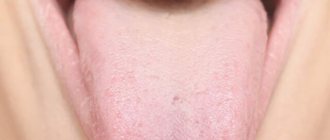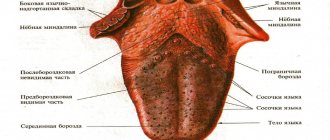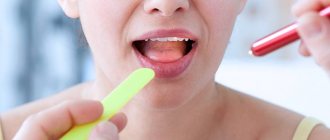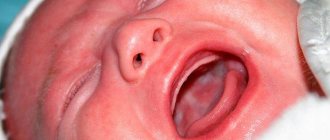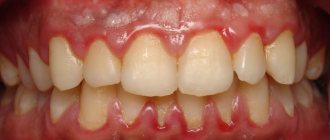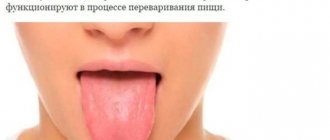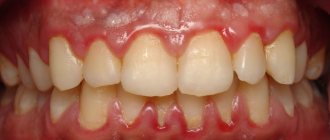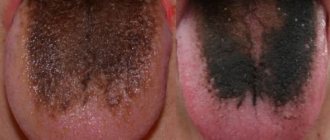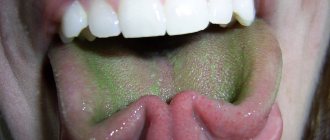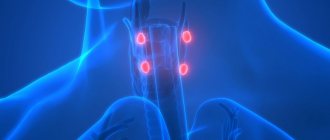A white tongue in a newborn after feeding is a common occurrence. These are milk residues; removing them from the surface will not be difficult. But the appearance of a thick, cheesy coating in the mouth, anxiety, and poor appetite in a child indicate more serious reasons and require the help of a pediatrician. The doctor will determine why the baby has a white coating on the tongue and will develop an effective treatment regimen.
How to distinguish “bad” plaque from “good”
Photo: this is what a “milky” white coating looks like on a baby’s tongue
The appearance of a white coating on the tongue of an infant is not always a signal of concern. Take a closer look at your baby and let him take 1-2 sips of boiled water. If there are no negative changes in behavior, the baby is calm, eats well, and after drinking the amount of plaque decreases, then it is milk residue.
In the first weeks of life, the baby's main food is mother's milk, and it is not surprising that its remains are present on the tongue.
If the white coating on the tongue of a month-old baby has a dense consistency in the form of curdled flakes, you should urgently take the baby to the doctor
. Such symptoms indicate the development of thrush and other disorders in the child’s body.
Pathological plaque does not appear “alone”; changes in the baby’s behavior and well-being should also be observed: the baby is capricious, cries, refuses to eat, body temperature rises, and poor sleep is possible.
Why does a baby have a white coating on the tongue?
Pediatricians identify the following factors that provoke the appearance of white plaque on the tongue of infants:
- weak, immature immunity;
- disruption of the gastrointestinal tract: constipation, dysbacteriosis, early complementary feeding, gastritis;
- treatment with antibiotics, allergies to them;
- low level of hemoglobin in the blood, vitamin deficiency;
- diabetes;
- hormonal changes, disruptions;
- infection through the mother's birth canal, through dirty toys, a pacifier;
- dry mouth.
Attention! Why a newborn has a white coating on the tongue and what measures to take to eliminate it are determined by a specialist after a detailed examination of the child. Self-medication is harmful to the baby’s health; do not give in to advice from TV or the Internet, even if it is from Dr. Komarovsky himself.
Whitish tongue as a sign of thrush
A white tongue in a newborn with a thick, dense coating often indicates a fungal infection of the oral cavity, which is accompanied by the development of candidiasis (thrush).
Thrush is a disease that develops due to the active activity of yeast-like fungi Candida. They can be located in the human body without causing discomfort or pain. If the environment becomes favorable for microorganisms, they actively multiply, affecting the mucous membranes of the oral cavity.
Children in the first month of life are more susceptible to the disease; they could have received the infection at birth. If the mother is diagnosed with Candida fungus, infection is inevitable.
Photo: this is what a white coating looks like on a baby’s tongue with thrush
There are mild and severe stages of fungal infection. Treatment of a mild form lasts 7 days without the formation of wounds or the development of complications. To get rid of a severe form of candidiasis, you will need the help of a pediatrician and drug therapy. It is important to constantly monitor changes in the color of the baby’s tongue and oral mucosa and his well-being. Possible complications, increased body temperature.
White tongue is a frequent guest in newborns who are bottle-fed. Breastfeeding helps prepare the baby's immune system to be attacked by viruses and harmful bacteria. In addition, the mother's warmth calms the baby's nervous system. “Artificial” people need more time to strengthen the immune system, which increases the chances of developing the disease
.
Fungal infection
The development of thrush in the child’s mouth occurs as a result of the growth of Candida fungi. Intensive reproduction of pathogenic microorganisms occurs as a result of the influence of various factors.
Often babies become infected with thrush during childbirth, crossing the birth canal
These include:
- Weakened immune system.
- Dysfunctions of the microflora of the gastrointestinal tract.
- Hormonal disorders.
- Conducting antibacterial therapy.
- Excessive dryness of the oral mucosa.
Infection with Candida fungi occurs under the following conditions:
- In utero. Infection can occur through the placenta, umbilical cord and amniotic fluid.
- During childbirth. Often babies become infected with thrush during childbirth, crossing the birth canal. Therefore, it is important for women to exclude the development of thrush, especially in the last stages of pregnancy.
- Finding a child in a hospital and maternity hospital. Inappropriate and non-sterile care of the child contributes to the child becoming infected from health care workers.
- Poor sanitary conditions at home. Babies are born with a weakened immune system. Therefore, keeping a child in an unsterile home environment promotes the penetration of various microorganisms and bacteria into his body.
Diagnosis of candidal glossitis involves a complete collection of anamnesis data and conducting various types of comprehensive research.
Important! In most cases, when diagnosing thrush in a child, an instrumental examination is not performed.
For these purposes the following is carried out:
- Microscopic examination of the oral mucosa by taking a scraping from plaque and then examining it under a microscope. This allows you to determine the presence of Candida mycelium threads and yeast-like cells.
- Bacteriological research. Allows you to identify the type of Candida fungus and the number of its colonies. Sowing mushrooms on a nutrient medium helps install the most effective antifungal drug. This is necessary, since many medications have different effects on grown fungal colonies.
- Serological study. It is carried out if necessary to study antibodies that are concentrated in the blood serum.
A newborn has a white coating on the tongue - what to do?
The method of treating white plaque on a baby's tongue
depends on the cause of its appearance
. If the whitish spots are the remains of breast milk or formula, you need to clean the baby’s tongue. Use boiled water to rinse the baby's mouth with it after feeding.
If the defect is caused by disorders of the nervous system, contact a pediatric neurologist to identify the cause of the neurosis and take care of the baby’s peace of mind. There is no need to clean the tongue; the defect will go away on its own.
The appearance of whitish spots on the tongue may mean that the baby has digestive problems. Pay attention to your child's nutrition. The primary task is to eliminate dysbiosis by selecting a different formula during artificial feeding or adjusting the mother’s diet during breastfeeding. These actions are enough to eliminate the symptoms.
A white coating on the tongue of a newborn child may appear due to infectious diseases of the oral mucosa: herpes, scarlet fever, chicken pox. The disease occurs with elevated body temperature.
It is impossible to do without drug treatment. To avoid complications and the disease becoming chronic, the doctor may refer the baby for inpatient treatment.
Treating thrush
Treatment of a mild stage of thrush involves wiping the tongue with a soda solution. With its help, you can easily clean whitish accumulations and prevent the growth of bacteria.
Pay more attention to personal hygiene rules:
- For “artificial” babies, be sure to pour boiling water over the nipple and bottle before feeding.
- Clean and boil rubber toys regularly.
- Replace outdated nipples with new ones in a timely manner, taking into account the manufacturer's recommendations.
- When breastfeeding, keep your nipples clean. Before latching your baby, do not forget to wash your breasts with warm water. During the treatment of the disease, additionally treat it with soda solution.
- During lactation, try to avoid taking antibiotics, normalize your diet, fill it with vitamin products.
- After feeding, remove milk residues.
Important point! Do not kiss a sick baby on the lips, do not lick the pacifier - you risk becoming infected yourself and adding harmful bacteria and viruses with your saliva. Even after recovery, refrain from such actions.
A dense, cheesy coating on the baby’s tongue, palate and gums, and the appearance of whitish pimples indicate a complex stage of thrush. Drug treatment is carried out in strict compliance with the doctor’s instructions, without violating the regimen. Immunomodulatory and antifungal drugs are prescribed.
How to clean the tongue of a newborn
The most important factor influencing the speed of recovery from thrush is oral hygiene. Parents can clean the surface of their baby's tongue at home. Procedure:
- Make a weak 2% soda solution: 1 tsp. Dissolve baking soda in a glass of boiled water.
- Before cleaning your newborn's tongue, wash your hands with plain soap. Wrap a little sterile bandage around the pad of your index finger.
- Soak a bandaged finger in a soda solution and massage the problem surface with it. You need to clean your tongue as carefully as possible, without pressing.
- Repeat the procedure after each feeding, 4-5 times a day.
In addition to soda solution, you can clean the child’s damaged mucous membranes with medicinal gruel. To prepare it, mix 1/2 tablet of Nystatin (125 thousand units) with 1 ml of liquid vitamin B12. Apply the resulting mixture to the gums, palate, and plaque-covered surface of the tongue. Repeat the treatment after each feeding.
To remove unpleasant plaque, traditional medicine advises using honey and lemon juice. Be careful, such components can cause an allergic reaction in the baby and complicate treatment.
Therapy methods
Treatment of candidiasis begins with treatment of the oral cavity. The first procedure is performed by a specialist at the appointment. Antiseptic agents are used to remove plaque. The doctor may then apply an antifungal agent.
The parent should closely monitor the dentist’s actions, since in the future they will have to treat the oral cavity themselves at home. The necessary medications will be prescribed by a specialist. Local antifungal agents are dangerous in case of overdose, especially for children, so you must strictly follow your doctor’s recommendations.
In advanced cases, medications are prescribed in the form of solutions, drops or tablets. There are few drugs available to treat candidiasis in children. Replacing them with adult counterparts is also dangerous. The dosage must be strictly observed.
A mandatory addition to the main therapy is maintaining good hygiene, good sleep, proper nutrition and taking measures to strengthen the immune system (eating healthy foods, taking pharmaceutical vitamins if necessary, walking, etc.).
Parting words for parents from doctors
A white tongue in a newborn as a symptom of thrush worries many parents. Timely elimination of the infection will relieve complications and the chronic form of the disease.
There are preventive measures, the observance of which will prevent the appearance of an unpleasant white coating in a one-month-old baby:
- Maximum hygiene and sanitation, especially in the first months after birth, until the child’s immune system gets stronger.
- After feeding, give your baby 1-2 tsp. boiled water, it removes the remaining milk.
- Strictly follow the pediatrician’s recommendations when creating your own diet (if breastfeeding), follow the rules for introducing complementary foods to your baby in order to maintain normal intestinal microflora and prevent dysbiosis.
- You should not lick your baby’s nipple, eat with one spoon, or kiss on the lips, so as not to transmit harmful bacteria and viruses with saliva.
- Buy your child separate dishes and cups.
- At the first symptoms of thrush development, or the slightest change in the color of the tongue, contact your pediatrician.
- The child sleeps with his mouth open, so if the room is hot, take measures to humidify the microclimate, ventilate the room more often and spend more time with the baby in the fresh air.
If you want your baby to be healthy, be attentive to such little things as changes in skin color and tongue. Don’t think about how to remove white plaque, focus your efforts on preventing its appearance.
Doctor Komarovsky’s opinion about white coating on the tongue of infants:
Treatment
Fungal diseases in children can be treated by a pediatrician, an infectious disease specialist or a dermatologist. If we are talking about the treatment of oral thrush, then therapy can also be carried out by a dentist.
The diagnosis of candidiasis is determined in most cases based on an examination of the oral cavity performed by a specialist. If there is any doubt, the doctor refers the patient for additional examinations. More often, to confirm the disease, a laboratory test is used to test a smear taken from the mouth for the presence of fungus.
Treatment of thrush in children requires an integrated approach. If the disease is not advanced, then local therapy is carried out in combination with measures to strengthen the immune system. In severe cases, oral candidiasis in children is treated with systemic drugs, local agents and compliance with preventive recommendations.
